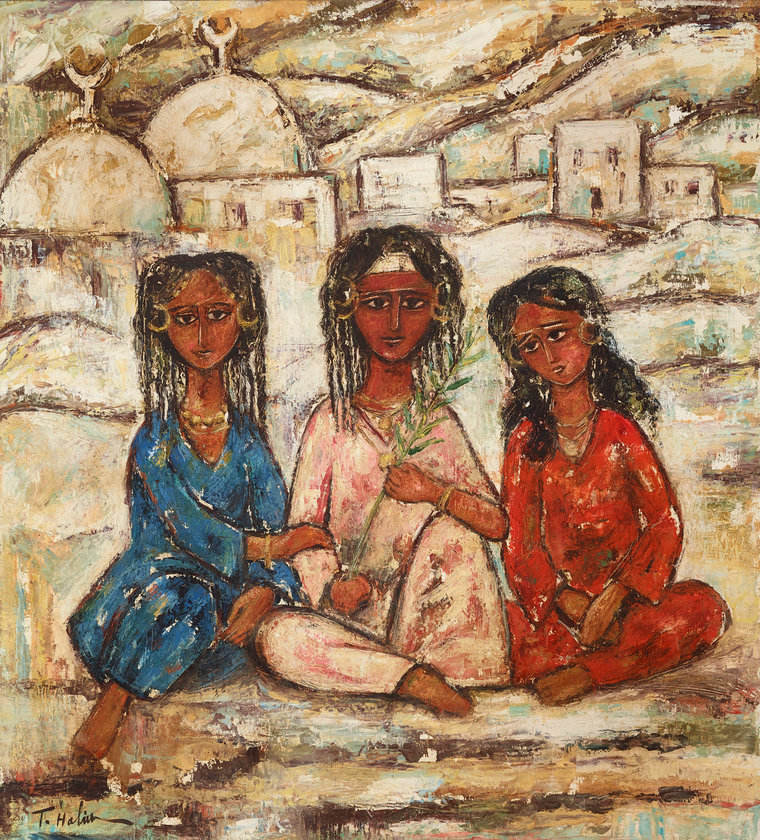Tahia Halim’s painting Three Nubians, n.d., is a poignant exploration of Nubian identity and femininity. The painting centers on three women seated by the Nile river, with one woman resting her hand on the arm of the central figure while the third gazes at her with concern, her eyebrows furrowed. The three women’s two-dimensional facial depiction and outlined figures recall the bas-reliefs of pharaonic art. Their solemn expressions, almond-shaped eyes, and serene postures evoke the appearance of Egyptian Coptic icons, with flat figures and minimal background depth. The women’s interaction with each other - the soft gaze from one and the gentle touch of the arm from the other – brings out the feminine aspects, especially the sense of comfort and community between the women.
As a matrilineal society, women played a significant role in the Nubian culture and were portrayed in their arts as strong leaders and queens. Known for their distinctive language and traditions, Nubians are a distinct cultural group along the Nile River in between Aswan in southern or Upper Egypt and Khartoum in northern Sudan. Halim became familiar with the Nubian history and culture through her trips to Nubia, where she was inspired by the daily rituals, legends, and myths she encountered. Her work celebrates Nubian peasants as vital guardians of Egyptian identity and traditions, emphasizing their connection to the land and their distance from colonialism.
Halim was born in Dongola, Sudan and spent most of her life in Cairo. She grew up in an aristocratic family, where her father was a first lieutenant in the Egyptian military, and chamberlain of King Fouad (1868-1936) in Cairo, and her mother – of Caucasian-Turkish origin – was a skilled oud-player. Although Halim came from an upper-class family, she always sympathized with the poor, and especially with women’s suffering. Contrary to other Egyptian women artists of her era, like Inji Efflatoun and Gazbia Sirry, who addressed women’s suffering without having personally endured pain (such as polygamy), Halim reflected on her personal injuries at the hands of men. Her short-lived marriage (1945-1946) had been tumultuous, as her husband’s rigid personality often led to conflicts. In addition to his disruptive temperament, he had secretly taken a second wife. When Halim discovered this betrayal, she divorced him.
Halim’s formal education was entrenched in Western art traditions and topics of the European Academy, such as nudes and genre scenes. However, in the wake of the 1956 British-French-Israeli attack on Egypt, she vowed to reject Western stylistic influences. Distancing herself from the influence of her mentor and ex-husband as well as her formal training, she developed a visual language that challenges European traditions through the lens of Nubian culture, drawing influence from ancient Egyptian bas-relief, Coptic tapestry, and icon painting.
Halim seriously engaged with Nubian culture themes after a government-sponsored trip in 1962, just before the completion of the Aswan High Dam, which flooded vast areas of Nubian land and displaced approximately 90,000 Nubians from their ancestral homes. The flooding submerged significant cultural sites and archaeological treasures, including ancient temples and relics integral to Nubian heritage, while many relocated Nubians struggled to preserve their language, customs, and social structures in unfamiliar environments. While her earlier works celebrated Nubian joy in the Aswan Dam project, her later pieces expressed the overlooked human cost of Egypt’s nationalist projects.
Halim remained free, independent, and unmarried for the rest of her life, dedicating herself to her art. In 1958, she became the first woman to receive the Guggenheim International Prize for her work, a significant achievement during a time when America was not supportive of female artists, especially women of color. She filled her home with dolls and traditional toys and spent time with her many cats, even famously abandoning an exhibition in Sweden when her favorite cat died. Halim also nurtured other artists, such as Hussein Bicar, who affectionately referred to her as Mama Tuha due to her generous spirit and loving personality.
Signed in English front lower right.




